Video
Hippocampus (3D-reconstruction, mouse). hippocampus.mpg File size 0.9 MB.
Guinea pigs (born 2011-09-16). GuineaPigs2011-09-17.MOV File size 871 MB. Duration 14:07 min. One-day-old animal with white body, "that's the hard one to get", is a female that will show very low water consumption being an adult. Her F1 female descendant will have unusually high water consumption.
Audio
Hatikva Hatikva_MidSide_wav_192_24 Hatikva_MidSide_MP3_48_16 (wav - 112.9 MB, MP3 - 3.2 MB). Hatikva.pdf (47 KB).
Feidman G. The Klezmer Wedding Book: An Anthology of Jewish Wedding Music: From the Repertoire of Giora Feidman. Arranged by Ofer Ben-Amots (ROM Productions, Flushing, NY, 1993). Music book. File size 1.6 MB.
Svyatoslav Knushevitski, cello: M. Reger, R. Strauss, J.S. Bach, F. Chopin, F. Mendelssohn, C. Saint-Saëns (Melodiya Record Company, Russia, 1948, 1952, 1956, 1964). CD, 1993. [CD cover] (PDF). Tracks: [1] [2] [3] [4] [5] [6] [7] [8] [9] [10] [11] [12] (MP3). SUCD 10-00543
Аркадий Северный. Вешние воды. 1979. A-Severni_Veshnie-vodi.mp3 File size 10.7 MB.
Textbooks
Koonin E.V. The Logic of Chance: The Nature and Origin of Biological Evolution (FT Press, Upper Saddle River, New Jersey, 2012). First published in 2011. File size 5.3 MB.
Vyssotski L.L. The Technology of Achievements (Siberian Branch of the Russian Academy of Sciences, Novosibirsk, 2011). Publ. in Russian: Высоцкий Л.Л. Технология достижений (Иэд-во СО РАН, Новосибирск, 2011). File size 3.3 MB.
Geodakian V.A. Two Sexes. Why? The Evolutionary Theory of Sex (Ed. by Sergey Geodakyan, Wilmington, 2012). File size 3.7 MB.
Geodakian V.A. Two Sexes - Why? The Evolutionary Theory of Sex (Ed. by Sergey Geodakyan, Wilmington, 2011). File size 2.4 MB.
Alberts B., Johnson A., Lewis J., Raff M., Roberts K. & Walter P. Molecular Biology of the Cell, 5th Ed. (Garland Science, New York, 2008). [Ch. 21, pp. 1269-1304] [Ch. 22, pp. 1305-1416] [Ch. 23, pp. 1417-1484] [Ch. 24, pp. 1485-1538] [Ch. 25, pp. 1539-1601]
Epigenetics. Eds. Allis C.D., Jenuwein T., Reinberg D. & Caparros M.-L. (Cold Spring Harbor, New York, 2007). File size 130 MB.
Altshuller G.S. & Vertkin I.M. How to Become a Genius: The Life Strategy of a Creative Person (Belarus Press, Minsk, 1994). Publ. in Russian: Альтшуллер Г.С., Верткин И.М. Как стать гением: Жизненная стратегия творческой личности (Беларусь, Минск, 1994). File size 8.0 MB.
Hoyle F. Mathematics of Evolution (Acorn Enterprises LLC, Memphis, Tennessee, 1999). First published in 1987. File size 7.7 MB.
Cognition and Fact: Materials on Ludwik Fleck (Boston studies in the philosophy of science ; v. 87). Eds. Cohen R.S. & Schnelle T. (D. Reidel Publishing Company, Dordrecht, 1986). File size 110 MB.
Altshuller G.S. Algorithm of Inventive Problem Solving (ARIZ-85c). First published in 1985. File size 0.4 MB.
Altshuller G.S. And Here the Inventor Appeared (2004). First published in 1984. File size 11 MB.
Solbrig O.T. & Solbrig D.J. Introduction to Population Biology & Evolution (Addison-Wesley, Reading, MA, 1979). File size 25 MB.
Макаренко Ю.А. и Судаков К.В. Анохин П.К. (Науч.-попул. мед. литература. Выдающиеся деятели отеч. медицины и здравоохранения) (Изд-во "Медицина", Москва, 1976). File size 3.6 MB.
Altshuller G.S. The Algorithm of an Invention (2007). First published in 1969. Second Edition, 1973. File size 22 MB.
Blacher L.I. The Problem of the Inheritance of Acquired Characters. A History of a priori and Empirical Methods Used to Find a Solution (Amerind, New Delhi, 1982). First published in 1971. File size 18 MB.
Eigen M. Self-organization of matter and the evolution of biological macromolecules. Naturwissenschaften 58, 465-523 (1971). File size 7.7 MB.
Anokhin P.K. Biology and Neurophysiology of the Conditioned Reflex and its Role in Adaptive Behavior (Pergamon Press, New York, 1974). First published in 1968. File size 36 MB.
Ravin A.W. The Evolution of Genetics (Academic Press, New York, 1965). File size 12 MB.
Horizons in Biochemistry. Albert Szent-Györgyi Dedicatory Volume. Kasha M. & Pullman B., Eds. (Academic Press, New York, 1962). File size 7.5 MB.
Rensch B. Neuere Probleme der Abstammungslehre: Die Transspezifische Evolution, 2nd ed (Ferdinand Enke Verlag, Stuttgart, 1954). File size 7.3 MB.
Selye H. The Story of the Adaptation Syndrome (Told in the Form of Informal, Illustrated Lectures) (Acta, Montreal, 1952). File size 16 MB.
Drosophila Guide. Introduction to the Genetics and Cytology of Drosophila melanogaster. Demerec M. & Kaufmann B.P. (Cornegie Institute of Washington, Washington DC, 1996). First published in 1940. Tenth Edition, 1996. File size 8.2 MB.
Goldschmidt R. The Material Basis of Evolution (Pageant Books, New Jersey, 1960). First published in 1940. File size 34 MB.
Fleck L. Genesis and Development of a Scientific Fact (The University of Chicago Press, Chicago, 1979). First published in 1935. File size 2.0 MB.
Harms J.W. Wandlungen des Artgefüges. Unter natürlichen und künstlichen Umweltbedingungen (Johann Ambrosius Barth Verlag, Leipzig, 1934). File size 7.5 MB.
Bergson H. The Two Sources of Morality and Religion (University of Notre Dame, Notre Dame, Indiana, 2002). First published in 1932. File size 17 MB.
Harms J.W. Die Realisation von Genen und die consecutive Adaption. 1. Phasen in der Differenzierung der Anlagenkomplexe und die Frage der Landtierwerdung. Zeitschr. wiss. Zool. 133, 211-397 (1929). File size 14 MB.
Berg L.S. Nomogenesis or Evolution Determined by Law (MIT Press, Cambridge, 1969). First published in 1922. File size 25 MB.
Bergson H. Creative Evolution (Dover Publ., Mineola, New York, 1998). First published in 1907. File size 5 MB.
Danilevski N.Ya. Darwinism: A Critical Study. Vol. 2 (St. Petersburg, 1889). Publ. in Russian: Данилевский Н.Я. Дарвинизм: Критическое исследование. Том 2 (С.-Петербург, 1889). File size 20 MB.
Danilevski N.Ya. Darwinism: A Critical Study. Vol. 1, Part 2 (St. Petersburg, 1885). Publ. in Russian: Данилевский Н.Я. Дарвинизм: Критическое исследование. Том 1, Часть 2 (С.-Петербург, 1885). File size 70 MB.
Danilevski N.Ya. Darwinism: A Critical Study. Vol. 1, Part 1 (St. Petersburg, 1885). Publ. in Russian: Данилевский Н.Я. Дарвинизм: Критическое исследование. Том 1, Часть 1 (С.-Петербург, 1885). File size 57 MB.
Publications of Other Authors
Byrnes J.J., Johnson N.L., Carini L.M. & Byrnes E.M. Multigenerational effects of adolescent morphine exposure on dopamine D2 receptor function. Psychopharmacol. 2013 Jan 13. DOI 10.1007/s00213-012-2960-1
Crews D. & Gore A.C. Epigenetic synthesis: a need for a new paradigm for evolution in a contaminated world. F1000 Biol. Rep. 4, 18 (2012).
Manikkam M., Guerrero-Bosagna C., Tracey R., Haque M.M. & Skinner M.K. Transgenerational actions of environmental compounds on reproductive disease and identification of epigenetic biomarkers of ancestral exposures. PLoS One 7(2), e31901 (2012). [Supporting Information]
Guerrero-Bosagna C.M. & Skinner M.K. Environmental epigenetics and phytoestrogen/phytochemical exposures. J. Steroid Biochem. Mol. Biol. (2012). doi:pii: S0960-0760(12)00271-3. 10.1016/j.jsbmb.2012.12.011.
Guerrero-Bosagna C., Covert T.R., Haque M.M., Settles M., Nilsson E.E., Anway M.D. & Skinner M.K. Epigenetic transgenerational inheritance of vinclozolin induced mouse adult onset disease and associated sperm epigenome biomarkers. Reprod. Toxicol. 34, 694-707 (2012). [Supplementary Information]
Guerrero-Bosagna C. & Skinner M.K. Environmentally induced epigenetic transgenerational inheritance of phenotype and disease. Mol. Cell. Endocrinol. (2011). doi:10.1016/j.mce.2011.10.004
Byrnes J.J., Babb J.A., Scanlan V.F. & Byrnes E.M. Adolescent opioid exposure in female rats: Transgenerational effects on morphine analgesia and anxiety-like behavior in adult offspring. Behav. Brain Res. 218, 200-205 (2011).
Frankel N., Erezyilmaz D.F., McGregor A.P., Wang S. Payre F. & Stern D.L. Morphological evolution caused by many subtle-effect substitutions in regulatory DNA. Nature 474, 598-603 (2011). [Supplementary Information]
Feng S., Jacobsen S.E. & Reik W. Epigenetic reprogramming in plant and animal development. Science 330, 622-627 (2010).
Skinner M.K., Anway M.D., Savenkova M.I., Gore A.C. & Crews D. Transgenerational epigenetic programming of the brain transcriptome and anxiety behavior. PLoS ONE 3(11), e3745 (2008). [Supplementary Information: S1, S2, S3, S4, S5, S6, S7, S8]
Stern D.L. & Orgogozo V. The loci of evolution: how predictable is genetic evolution? Evolution 62, 2155-2177 (2008).
Evans P.D., Mekel-Bobrov N., Vallender E.J., Hudson R.R. & Lahn B.T. Evidence that the adaptive allele of the brain size gene microcephalin introgressed into Homo sapiens from an archaic Homo lineage. Proc. Natl. Acad. Sci. USA 103, 18178-18183 (2006).
Evans P.D., Gilbert S.L., Mekel-Bobrov N., Vallender E.J., Anderson J.R., Vaez-Azizi L.M., Tishkoff S.A., Hudson R.R. & Lahn B.T. Microcephalin, a gene regulating brain size, continues to evolve adaptively in humans. Science 309, 1717-1720 (2005).
Byrnes E.M. Transgenerational consequences of adolescent morphine exposure in female rats: effects on anxiety-like behaviors and morphine sensitization in adult offspring. Psychopharmacol. 182, 537-544 (2005).
Engler P., Haasch D., Pinkert C.A., Doglio L., Glymour M., Brinster R. & Storb U. A strain-specific modifier on mouse chromosome 4 controls the methylation of independent transgene loci. Cell 65, 939-947 (1991).
Allen N.D., Norris M.L. & Surani M.A. Epigenetic control of transgene expression and imprinting by genotype-specific modifiers. Cell 61, 853-861 (1990).
Auroux M., Dulioust E., Selva J. & Rince P. Cyclophosphamide in the F0 male rat: physical and behavioral changes in three successive adult generations. Mutat. Res. 229, 189-200 (1990).
Auroux M.R., Dulioust E.JB., Nawar N.NY., Yacoub S.G., Mayaux M.J., Schwartz D. & David G. Antimitotic drugs in the male rat: behavioral abnormalities in the second generation. J. Androl. 9, 153-159 (1988).
Nei M. Human evolution at the molecular level. In Population Genetics and Molecular Evolution, Ohia T. & Aoki K., Eds. (Japan Sci. Soc. Press, Tokyo, 1985), pp. 41-64.
Lovejoy C.O. The origin of man. Science 211, 341-350 (1981).
Buselmaier W., Vierling Th., Balzereit W. & Schwegler H. Genetic analysis of avoidance learning by means of different psychological testing systems with inbred mice as model organisms. Psychol. Res. 43, 317-333 (1981).
Bakke J.L., Lawrence N.L., Robinson S. & Bennett J. Observations on the untreated progeny of hypothyroid male rats. Metabolism 25, 437-444 (1976).
Bakke J.L., Lawrence N.L., Bennett J. & Robinson, S. Endocrine syndrome produced by neonatal hyperthyroidism, hypothyroidism, or altered nutrition and effects seen in untreated progeny. In Perinatal Thyroid Physiology and Disease, Fisher D.A. & Burrow G.H., Eds. (Raven Press, New York, 1975), pp. 79-116.
Geodakian V.A. Why two sexes? Nauka i Zhizn (Science and Life) No 3, 99-105 (1966). Translated from Russian by B. Lubachevsky. www.geodakian.com
Geodakian V.A. The role of sexes in transmission and transformation of genetic information. Problems of Information Transmission 1, 105-112 (1965). Publ. in Russian: Геодакян В.А. Роль полов в передаче и преобразовании генетической информации. Пробл. Передачи Информ., Том 1, Вып. 1, стр. 105-112 (1965).
Schmitt F.O. Patterns of interaction of biological macromolecules in relation to cell function. Proc. Natl. Acad. Sci. USA 42, 806-810 (1956).
Lysenko T.D. The situation in biological science. In Lysenko T.D. Agrobiology. Essays on Problems of Genetics, Plant Breeding and Seed Growing (Foreign Languages Publishing House, Moscow, 1954), pp. 515-554. First published in 1948.
Horowitz N.H. On the evolution of biochemical syntheses. Proc. Natl. Acad. Sci. USA 31, 153-157 (1945).
Goldschmidt R. Some aspects of evolution. Science 78, 539-547 (1933).
Muller H.J. Further studies on the nature and causes of gene mutations. Proc. Int. Congr. Genet. 6th. 1, 213-255 (1932).
Morgan T.H. The theory of the gene. The American Naturalist 51, 513-544 (1917).
Morgan T.H. Chromosomes and heredity. The American Naturalist 44, 449-496 (1910). |
|
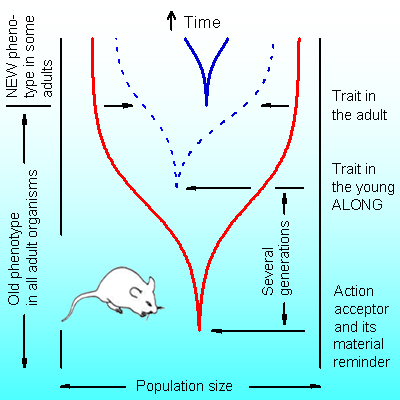
Abstract. The desired result of any process is represented in an organism by an action acceptor, consisting of two parts: the part which is absent yet and the part that is represented by material reminders of the said action acceptor. The absent part belongs to ideation space. There is no physical time in the ideation space: all entities are given simultaneously. The entities comprise, in general, a computably non-enumerable set – one entity can contain in itself one or more the same or different entities (no conservation laws). This feature provides the possibility to resolve contradictions that are unsolvable in 3D physical space. Evolution proceeds through the interaction of ideation space with 3D physical space by means of action acceptors. The development of each action acceptor precedes the appearance of its positive result by several generations and consists of selection of its material reminders through the self-election of organisms for differential reproduction.
Supplementary Audio MP3 for Vyssotski, 2024.
Supplementary Audio WAV for Vyssotski, 2024.
_________________________
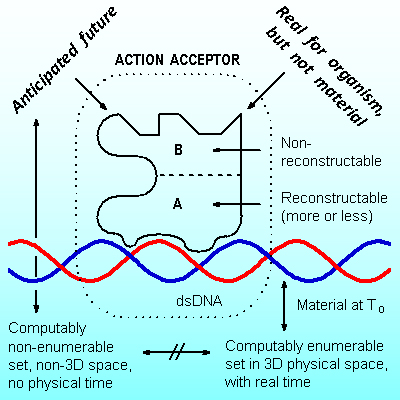
Abstract. The formation of a hybrid phenotype in mammals remains a mystery. In order to resolve this mystery we have chosen inbred mouse strains C57BL/6J and DBA/2J, and their F1 hybrid B6D2F1, took only females for experiment and housed them during postnatal days P22-P60 either in standard or enriched living conditions, always 4 mice per cage. This adolescent cage enrichment has evoked either induction of hybrid vigour or its significant enhancement, observed in different operant behavioural tasks during the rest of their life (Morris water maze, Go/NoGo sound frequency and sound duration discrimination tasks). This induction or enhancement can be understood only if ontogenesis is an active process, driven by action acceptors – by entities that percept the achievement of positive developmental results, even if the last ones have appeared with a help of random or unexpected factors of stochastic or genetic nature. The same way action acceptors direct evolution on Earth.
Supplementary Information for Vyssotski, 2019.
Full Text + SI (Combined PDF)
_________________________

Abstract. Neurologger has been originally designed to record EEG, local field potentials and neuronal activity in freely moving animals in their natural environments. Later its spectrum of applicability was extended to EMG and ECG recording. Recently Neurologger has been applied to study of auditory communication in animals and, thanks to increased up to 200 kHz sampling rate in single-channel mode, to study of ultrasonic echolocation in bats. Today Neurologger is represented by two versions: Neurologger 2A/2B and Neurologger 3. Neurologger 2A/2B remains our lightest version (1.3 g without battery) and it is capable to record up to 4 channels at 33.3 kHz, 10-bit into soldered on board memory (1 or 2 GB). Neurologger 3 is slightly heavier (1.7 g without battery), it records up to 32 channels at 20.8 kHz, 16-bit into microSDXC card (4-256 GB) and it has remote control and data access through BlueTooth communication with Windows 10 machines.
Supplementary Information for "Neurologger 3 and its history", 2016.
Full Text + SI (Combined PDF)
_________________________
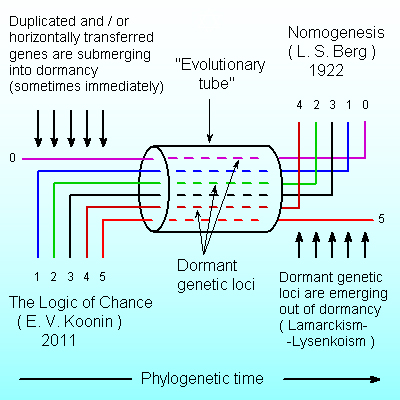
Abstract. Evolution of available genomes was shown to be proceeding through random changes, the changes that comprise the main modus of evolution (Koonin, 2011). Morphological evolution of available and extinct Metazoa was shown to be going on the basis of law, by means of precession of characters, where characters originally manifested in the young along in the course of time and evolution were displayed also in adult descendants (or supposed descendants) of that organism (Berg, 1922). This contradiction is obviously solved in nature, where the appearance of any new genetic locus in the genome and its further expression in the phenotype can be separated by unlimited period of time and by unlimited number of generations. The management of dormant genetic loci has come from the previous evolutionary stage, unimaginable today, where organisms were open systems with respect to the flow of genetic elements and were collecting, discriminating and storing genetic elements from the external environment. This was an important period when multiple systems for blocking and unblocking of genetic loci came into being. However even before this stage, it was even more fantastic evolutionary period where replication, transcription and translation were absent and Eigen cycle was not possible, but organisms were collecting randomly available components (proteins, RNA and DNA) by means of action acceptors (Anokhin, 1955) – sites of double-stranded DNA mechanically compatible with useful components. Action acceptors themselves were unable to be replicated by modern way (no DNA polymerase!), but they were collecting their pseudo-copies from the environment – the pieces of DNA that were born in the environment and occurred to be compatible by chance with current action acceptors. Action acceptors, – the structures that sense presumably useful results or substances, were directing evolution from the early beginning and they are directing it today through activation and deactivation of dormant genetic loci.
Supplementary Information for Vyssotski, 2016.
Full Text + SI (Combined PDF)
_________________________
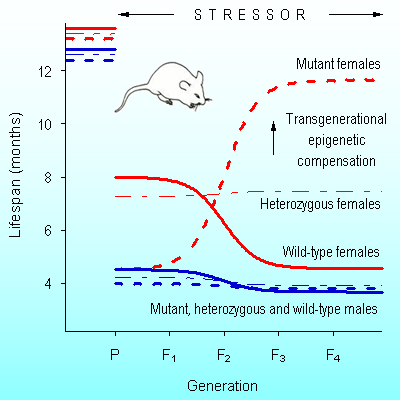
Abstract. The term “epigenetics” defines all meiotically and mitotically heritable changes in gene expression that are not coded in the DNA sequence itself. Transgenerational epigenetic compensation was discovered in the untreated progeny of drug-treated males (rats and mice) as the opposite quantitative phenotypic changes. In natural populations, the hereditary basis of transgenerational epigenetic compensation develops mainly in homozygous mutant males, but it does not affect their phenotype. In their descendants, being in an independent locus, this heritable epigenetic compensation increases fitness and lifespan of homozygous mutant females and decreases lifespan of wild-type females, starting from F2. Here we show that this transgenerational epigenetic compensation is a guiding agent of natural selection. Natural selection is not a directing or driving force of evolution anymore. Natural selection needs some guidance. Transgenerational epigenetic compensation can initiate speciation through segregation of mutants and wild-types and/or it can change the selection coefficient of a given mutation.
Supplementary Information for Vyssotski, 2014.
Full Text + SI (Combined PDF)
_________________________
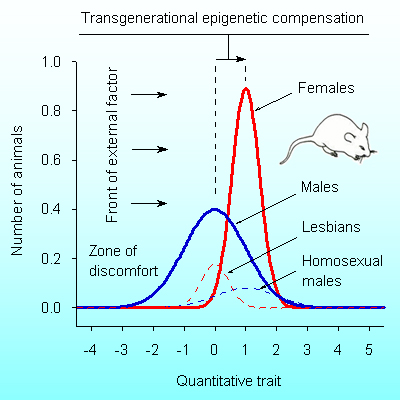
Abstract. The term “epigenetics” defines all meiotically and mitotically heritable changes in gene expression that are not coded in the DNA sequence itself. Transgenerational epigenetic compensation was discovered in the untreated progeny of drug-treated males (rats and mice) as the opposite quantitative phenotypic changes. In natural populations, heritable epigenetic compensation can convert mutants into hopeful monsters, initiates speciation, and therefore determines the route of macroevolution. Transgenerational epigenetic compensation facilitates genetic assimilation of acquired characters in microevolution. The ontogenesis of females is better canalized than that one of males, and natural selection proceeds mainly through selection of males. However the presence of sexual dimorphism in transgenerational epigenetic compensation remains unclear. Here we show that the hereditary basis of transgenerational epigenetic compensation develops mainly in males. However the phenotypic results of this development are more pronounced in their female descendants, starting from F2. This sexual dimorphism enhances the efficiency of micro- and macroevolution.
Supplementary Information for Vyssotski, 2013.
Full Text + SI (Combined PDF)
_________________________
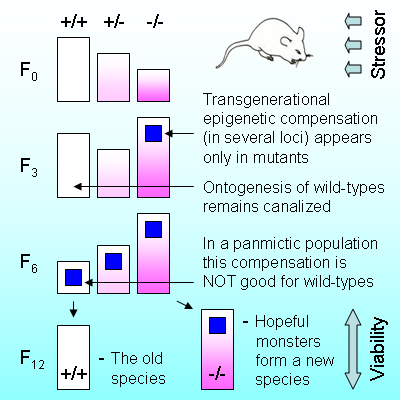
Abstract. The term “epigenetics” defines all meiotically and mitotically heritable changes in gene expression that are not coded in the DNA sequence itself. Transgenerational epigenetic compensation of disturbed functionality was discovered in the untreated progeny of drug-treated fathers as the opposite quantitative phenotypic changes (phenotypic inversion). Epigenetic changes, responsible for heritable compensation, are distributed between several independent loci and these changes disappear gradually and asynchronously during a few untreated generations. The role of hereditary epigenetic compensation in evolution remains unclear. Here we show that transgenerational epigenetic compensation of disturbed functionality converts mutants into hopeful monsters, initiates speciation and facilitates genetic assimilation of acquired characters. The increase of environmental pressure, applied to mutant and wild-type animals, induces heritable epigenetic compensation in mutants (initially less fit), whereas the development of wild-types remains canalized. In a random breeding population this heritable epigenetic compensation increases fitness and lifespan of mutants and decreases lifespan of wild-types.
Supplementary Information for Vyssotski, 2012.
Full Text + SI (Combined PDF)
_________________________
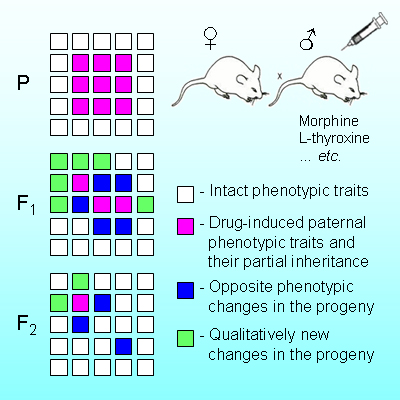
Abstract. The term “epigenetics” defines all meiotically and mitotically heritable changes in gene expression that are not coded in the DNA sequence itself. The ability of environmental factors to reprogram the germ line and to promote transgenerational disease states has significant implications for evolutionary biology. However, the biological function of transgenerational epigenetic inheritance remains unclear. Here we show that epigenetic inheritance promotes transgenerational compensation of disturbed functionality. After chronic morphine treatment of male Wistar rats or neonatal thyroxine treatment of male DBA/2J mice many of the changes discovered in the untreated progeny occurred to be the opposite of those observed in the treated fathers themselves. Phenotypic analysis of the untreated F1-F3 generations has revealed several independent epigenetically modified loci. Transgenerational epigenetic compensation was observed in the F2-F3 and further generations of transgenic Per2(Brdm1) mice raised under semi-natural outdoor conditions and it was localized not in the same locus as original mutation.
Supplementary Information for Vyssotski, 2011.
Full Text + SI (Combined PDF)
|
|
Publications
Evolocus Neuroscience-2024 Special Issue. File size 23 MB.
Evolocus Neuroscience-2019 Special Issue. File size 20 MB.
Evolocus Neuroscience-2016 Special Issue. File size 19 MB.
Our Publications
Vyssotski M. Action acceptor in evolution. Evolocus 1, 37-53 (2024).
Vyssotski D.L. Hybrid vigour and hybrid dysgenesis. Evolocus 1, 31-36 (2019). [Supplementary Information]
Neurologger 3 and its history. Evolocus 1, I-VI (2016). [Supplementary Information]
Vyssotski D.L. Nomogenesis and the logic of chance. Evolocus 1, 25-30 (2016). [Supplementary Information]
Vyssotski D.L. Transgenerational epigenetic compensation and natural selection. Evolocus 1, 19-24 (2014). [Supplementary Information]
Vyssotski D.L. Transgenerational epigenetic compensation and sexual dimorphism. Evolocus 1, 13-18 (2013). [Supplementary Information]
Vyssotski D.L. Transgenerational epigenetic compensation in evolution. Evolocus 1, 7-12 (2012). [Supplementary Information]
Vyssotski D.L. Transgenerational epigenetic compensation. Evolocus 1, 1-6 (2011). [Supplementary Information]
Vyssotski D.L. Transgenerational Epigenetic Compensation of Paternal Drug Treatment. Supporting Online Material (Evolocus, New York, 2010). [Erratum]
Vyssotski D.L. The Last Trick of Neuroevolution. An Addition to the Book "Elements of Biological Concepts" (Evolocus, New York, 2007). Publ. in Russian: Д.Л. Высоцкий, Последний трюк нейроэволюции. Дополнение к книге "Элементы биологических концепций" (Эволокус, Нью-Йорк, 2007).
Vyssotski D.L. Elements of Biological Concepts (Nauka, Novosibirsk, 2004). Publ. in Russian: Д.Л. Высоцкий, Элементы биологических концепций (Наука, Новосибирск, 2004), ISBN 5-02-032061-7.
Other Publications
Lesku J.A., Meyer L.C.R., Fuller A., Maloney S.K., Dell'Omo G., Vyssotski A.L. and Rattenborg N.C. (2011) Ostriches sleep like platypuses. PLoS One, 6(8):e23203. [Figure S1] [Figure S2] [Movie] [Supplementary Text]
Tsoar A., Nathan R., Bartan Y., Vyssotski A., Dell'Omo G. and Ulanovsky N. (2011) Large-scale navigation map in a mammal. Proc Natl Acad Sci USA, Aug. 15 (Epub ahead of print). [Supporting Information] [Movie]
Daan S., Spoelstra K., Albrecht U., Schmutz I., Daan M., Daan B., Rienks F., Poletaeva I., Dell'Omo G., Vyssotski A., and Lipp H.-P. (2011) Lab mice in the field: unorthodox daily activity and effects of a dysfunctional circadian clock allele. J Biol Rhythms, 26(2): 118-29. [Supplementary Online Material]
Pang D.S., Robledo C.J., Carr D.C., Gent T.C., Vyssotski A.L., Caley A, Zecharia A., Wisden W., Brickley S.G., and Frank N.P. (2009) An unexpected role for TASK-3 potassium channels in network oscillations with implications for sleep mechanisms and anesthetic action. Proc Natl Acad Sci USA, 2009 Oct 13; 106(41):17546-51.
Vyssotski A.L., Dell'Omo G., Dell'Ariccia G., Abramchuk A.N., Serkov A.N., Latanov A.V., Loizzo A., Wolfer D.P., and Lipp H.-P. (2009) EEG responses to visual landmarks in flying pigeons. Curr Biol. 19(14), 1159-1166. [Supplement]
Rattenborg N.C., Voirin B., Vyssotski A.L., Kays R.W., Spoelstra K., Kuemmeth F., Heidrich W.,and Wikelski M. (2008) Sleeping outside the box: electroencephalographic measures of sleep in sloths inhabiting a rainforest.
Biol Lett. 4(4):402-5. [Supplement]
Vyssotski A.L., Serkov A.N., Itskov P.M., Dell'Omo G., Latanov A.V., Wolfer D.P., and Lipp H.-P. (2006) Miniature neurologgers for flying pigeons: multichannel EEG and action and field potentials in combination with GPS recording. J Neurophysiol 95: 1263-1273.
Vyssotski, A.L., Dell'Omo, G., Poletaeva, I.I., Vyssotski, D.L., Minichiello, L., Klein, R., Wolfer, D.P., and Lipp, H.-P. (2002). Long-term monitoring of hippocampus-dependent behavior in naturalistic settings: mutant mice lacking the neurotrophin receptor TrkB in the forebrain show spatial learning but impaired behavioral flexibility. Hippocampus 12, 27-38.
Vyssotski D.L. Acute and Chronic Effects of Morphine in the Progeny of Male Rats with Opiate Dependence (Institute of Normal Physiology, Moscow, 2001). Ph.D. thesis in Russian: Высоцкий Д.Л. Острые и хронические эффекты морфина у потомства крыс-самцов с опиатной зависимостью (НИИ НФ РАМН, Москва, 2001). File size 36 MB.
Vysotskii A.L., Vysotskii D.L., Gudasheva T.A., Ostrovskaya R.U., Anokhin K.V. (1999). Modulation of long-term memory by delayed administration of the Amide of L-Pyroglutamyl-D-alanine, a nootropic agent, in spaced and massed training in rats. – Neuroscience and Behavioral Physiology, 29(2), 137-142.
Publications of Other Authors
Weyrich A., Lenz D., Jeschek M., Chung T.H., Rübensam K., Göritz F., Jewgenow K. & Fickel J. Paternal intergenerational epigenetic response to heat exposure in male Wild guinea pigs. Mol. Ecol. 25, 1729-1740 (2016).
Skinner M.K., Guerrero-Bosagna C., Haque M., Nilsson E., Bhandari R. & McCarrey J.R. Environmentally induced transgenerational epigenetic reprogramming of primordial germ cells and the subsequent germ line. PLoS One 8(7), e66318 (2013). [Supplementary Information: s1, sT1, sT2]
Skinner M.K. Environmental epigenetics and epigenetic transgenerational inheritance. In Environmental Epigenomics in Health and Disease: Epigenetics and Disease Origins, Jirtle R.L. & Tyson F.L., Eds. (Springer-Verlag, Berlin, 2013), pp. 245-256.
Skinner M.K., Manikkam M., Haque M.M., Zhang B. & Savenkova M.I. Epigenetic transgenerational inheritance of somatic transcriptomes and epigenetic control regions. Genome Biology 13, R91 (2012).
Perreau-Lenz S., Sanchis-Segura C., Leonardi-Essmann F., Schneider M. & Spanagel R. Development of morphine-induced tolerance and withdrawal: involvement of the clock gene mPer2. Eur. Neuropsychopharmacol. 20, 509-517 (2010).
Theissen G. Saltational evolution: hopeful monsters are here to stay. Theory Biosci. 128, 43-51 (2009).
Schneider S., Kaufmann W., Buesen R. & van Ravenzwaay B. Vinclozolin - The lack of a transgenerational effect after oral maternal exposure during organogenesis. Reprod. Toxicol. 25, 352-260 (2008).
Crews D., Gore A.C., Hsu T.S., Dangleben N.L., Spinetta M., Schallert T., Anway M.D. & Skinner M.K. Transgenerational epigenetic imprints on mate preference. Proc. Natl. Acad. Sci. USA 104, 5942-5946 (2007). [Supporting Information] [Movie]
Koonin E.V. The cosmological model of eternal inflation and the transition from chance to biological evolution in the history of life. Biology Direct 2, 15 (2007).
Zuckerkandl E. & Cavalli G. Combinatorial epigenetics, “junk DNA”, and the evolution of complex organisms. Gene 390, 232-242 (2007).
Theissen G. The proper place of hopeful monsters in evolutionary biology. Theory Biosci. 124, 349-369 (2006).
Zlotin B. & Zusman A. A Natural Brain for Intelligent Design (Ideation International, Southfield, Michigan, 2005).
Anway M.D., Cupp A.S., Uzumcu M. & Skinner M.K. Epigenetic transgenerational actions of endocrine disruptors and male fertility. Science 308, 1466-1469 (2005). [Supporting Online Material]
Mirkin B.G., Fenner T.I., Galperin M.Y. & Koonin E.V. Algorithms for computing parsimonious evolutionary scenarios for genome evolution, the last universal common ancestor and dominance of horizontal gene transfer in the evolution of prokaryotes. BMC Evolutionary Biology 3, 2 (2003).
Mirkin B. & Koonin E. A top-down method for building genome classification trees with linear binary hierarchies. In Bioconsensus, Janowitz M., Lapointe J.-F., McMorris F., Mirkin B. & Roberts F., Eds. (DIMACS Series, Vol. 61, AMS, Providence, 2003), pp. 97-112.
Cicero T.J., Nock B. & Meyer E.R. Gender-linked differences in the expression of physical dependence in the rat. Pharmacol. Biochem. Behav. 72, 691-697 (2002).
Segré D. & Lancet D. Composing life. EMBO Reports 1(3), 217-222 (2000).
Schwartz J.H. Homeobox genes, fossils, and the origin of species. Anat. Rec. 257, 15-31 (1999).
Agrawal A.A., Laforsch C. & Tollrian R. Transgenerational induction of defences in animals and plants. Nature 401, 60-63 (1999).
Banko M.L., Allen K.M., Dolina S., Neumann P.E. & Seyfried T.N. Genomic imprinting and audiogenic seizures in mice. Behav. Genet. 27, 465-475 (1997).
Cicero T.J., Nock B. & Meyer E.R. Gender-related differences in the antinociceptive properties of morphine. J. Pharmacol. Exp. Ther. 279, 767-773 (1996).
Friedler G. Paternal exposures: impact on reproductive and developmental outcome. An overview. Pharmacol. Biochem. Behav. 55, 691-700 (1996).
Cicero T.J., Nock B., O'Connor L., Adams M.L. & Meyer E.R. Adverse effects of paternal opiate exposure on offspring development and sensitivity to morphine-induced analgesia. J. Pharmacol. Exp. Ther. 273, 386-392 (1995).
Scharloo W. Canalization: genetic and developmental aspects. Annu. Rev. Ecol. Syst. 22, 65-93 (1991).
Eriksson P.S. & Ronnback L. Effects of prenatal morphine treatment of rats on mortality, bodyweight and analgesic response in the offspring. Drug Alcohol Depend. 24, 187-194 (1989).
Eriksson P.S., Ronnback L. & Hansson E. Do persistent morphine effects involve interactions with the genome? Drug Alcohol Depend. 24, 39-43 (1989).
Campbell J.H. & Perkins P. Transgenerational effects of drug and hormonal treatments in mammals: a review of observations and ideas. Prog. Brain Res. 73, 535-553 (1988).
Ho M.W., Tucker C., Keeley D. & Saunders P.T. Effects of successive generations of ether treatment on penetrance and expression of the bithorax phenocopy in Drosophila melanogaster. J. Exp. Zool. 225, 357-368 (1983).
Belyaev D.K., Ruvinsky A.O., Agulnik A.I. & Agulnik S.I. Effect of hydrocortisone on the phenotypic expression and inheritance of the Fused gene in mice. Theor. Appl. Genet. 64, 275-281 (1983).
Belyaev D.K., Ruvinsky A.O. & Trut L.N. Inherited activation-inactivation of the star gene in foxes. J. Hered. 72, 267-274 (1981).
Belyaev D.K., Ruvinsky A.O. & Borodin P.M. Inheritance of alternative states of the fused gene in mice. J. Hered. 72, 107-112 (1981).
Belyaev D.K. Destabilizing selection as a factor in domestication. J. Hered. 70, 301-308 (1979).
Smith D.J. & Joffe J.M. Increased neonatal mortality in offspring of male rats treated with methadone or morphine before mating. Nature 253, 202-203 (1975).
Vuillaume M. & Berkaloff A. LSD treatment of Pieris brassicae and consequences on the progeny. Nature 251, 314-315 (1974).
Durrant A. The environmental induction of heritable change in Linum. Heredity 17, 27-61 (1962).
Zuckerkandl E. & Pauling L. Molecular disease, evolution, and genic heterogeneity. In Horizons in Biochemistry, Kasha M. & Pullman B., Eds. (Academic Press, New York, 1962), pp. 189-225.
Platt J.R. A "book model" of genetic information-transfer in cells and tissues. In Horizons in Biochemistry, Kasha M. & Pullman B., Eds. (Academic Press, New York, 1962), pp. 167-187.
Paigen K. & Noell W.K. Two linked genes showing a similar timing of expression in mice. Nature 190, 148-150 (1961).
Thoday J.M. & Boam T.B. Effects of disruptive selection: II. Polymorphism and divergence without isolation. Heredity 13, 205-218 (1959).
Thoday J.M. Effects of disruptive selection: I. Genetic flexibility. Heredity 13, 187-203 (1959).
Альтшуллер Г. и Шапиро Р. Изгнание Шестикрылого Серафима. Изобретатель и рационализатор, 1959, № 10, стр. 20-30.
McClintock B. Controlling elements and the gene. Cold Spring Harb. Symp. Quant. Biol. 21, 197-216 (1956).
Waddington C.H. Genetic assimilation of the bithorax phenotype. Evolution 10, 1-13 (1956).
Altshuller G.S. & Shapiro R.B. On the psychology of inventors' creativity. Problems of Psychology (6), 37-49 (1956). Puibl. in Russian: Альтшуллер Г.С. и Шапиро Р.Б. О психологии изобретательского творчества. Вопр. психол., 1956, № 6, стр. 37-49.
Anokhin P.K. New data on the characteristics of the afferent mechanism of the conditioned reflex and their significance for psychology. Problems of Psychology (6), 16-38 (1955). Publ. in Russian: Анохин П.К. Новые данные об особенностях афферентного аппарата условного рефлекса и их значение для психологии. Вопр. психол., 1955, № 6, стр. 16-38.
Waddington C.H. Genetic assimilation of an acquired character. Evolution 7, 118-126 (1953).
Waddington C.H. Canalization of development and the inheritance of acquired characters. Nature 150, 563-565 (1942).
Fleck L. Some specific features of the medical way of thinking. In Cognition and Fact - Materials on Ludwik Fleck, Cohen R.S. & Schnelle T., Eds. (D. Riedel Publishing Company, Dordrecht, 1986), pp. 39-46. First published in 1927.
Studentsov N.P. The inheritance of domestication in white mice. Rus. Physiol. J. 7, 317-318 (1924) [Publ. in Russian: Н.П. Студенцов, Наследование прирученности у белых мышей. Рус. физиол. журн. 7 (вып. 1-6), 317-318 (1924)].
Pawlow I.P. New researches on conditioned reflexes. Science 58 (Vol. LVIII, No. 1506), 359-361 (1923).
Vavilov N.I. The law of homologous series in variation. J. Genet. 12(1), 47-89 (1922). |








